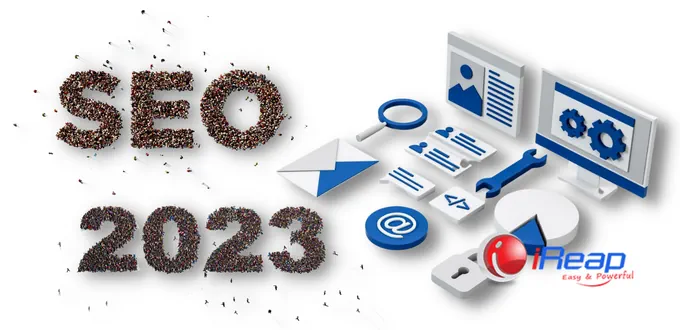
SEO or Search Engine Optimization is a technique or effort to increase a site’s ranking in search engines like Google.
It works by optimizing the website (on-page SEO) and the website (off-page SEO) to make it more relevant and authoritative for search engines.
So, to improve your business website ranking in search engines, you need to do both on-page and off-page SEO optimization. Come on, find out how by reading this article.
On-Page SEO Optimization
On-page SEO optimization is optimization that is done on your website.
This means you must improve all elements on your business site, such as content structure, meta descriptions, etc.
The goal is to help search engines understand the content and purpose of your website. How to do on-page SEO optimization? Here are some of them:
1. Do Keyword Research and Use It Wisely
Using appropriate and relevant keywords is an essential part of on-page SEO optimization. Do keyword research first and choose the keywords that best suit your business.
Keyword research or keyword research is using specific keywords that internet users often use to find relevant content for your product or business.
Keywords are usually scattered in the article. I am not spamming, but using a combination of short tail keywords, long tail keywords, and LSI (Latent Semantic Indexing).
2. Create and Deliver High-Quality Content
Informative, useful, and original content will help a business site gain authority on certain topics and ultimately increase rankings in search engines.
Therefore, provide content (by implementing content marketing) as a source of information and solutions that can help consumers solve their problems and meet their needs.
Especially in today’s digital era, most consumers prefer to find solutions on search engines.
For example: how does a coffee machine work? What is the name of the tool that can clean between the beds?

3. Optimize Heading Tags, Meta Description, and Title Tags
Make sure you have implemented heading tags in every business site’s content.
Heading tags are part of the structure of web pages that can help audiences and search engines understand the content.
The H1 heading tag is generally used for the main title of a web page. Then H2, H3, H4, and so on become sub-headings or part of the page/content.
Then, it would help if you also use meta descriptions and title tags in on-page SEO optimization.
To do this, you can write informative meta descriptions and title tags to encourage your audience to click on your website links that appear in search results on search engines.
4. Optimize Images to Increase Loading Speed and Add Alt Text
Loading speed affects the site’s speed when the audience visits a business site.
That’s why you need to pay attention to this—for example, optimizing the images used, starting from the size and pixels, using the .webp extension.
Also, add descriptive alt text to images so search engines can understand the image content and match it to your search audience.
Alt text also helps people with visual impairments understand image content.
5. Optimize URLs and Use Internal Links
You can optimize the URL by entering keywords in the URL or modifying the URL (the URL doesn’t have to be the same as the title).
Examples like this article. The article’s title is How to Do On-Page and Off-Page SEO Optimization on a Business Site.
Then the URL is optimized to be shorter for SEO optimization. Then the URL that appears will be: https://www.ireappos.com/news/id/optimasi-seo/
It would help if you also used internal links (links within content) that connect one range to another that is still related/relevant.
This is because it is better to provide some specific but related content than to write one long article and tire the audience from reading it.
Off-Page SEO Optimization
Off-page SEO optimization is done from outside your business website—the goal is to increase website authority and trust in search engines.
In doing so, you must create or build backlinks, increase visibility on social media, and much more. Here’s a complete off-page SEO optimization method that you can apply:

1. Build Quality Backlinks
Backlinks or backlinks from authoritative and high-quality websites can help increase a website’s ranking in search engines.
But make sure when building these backlinks, build them organically, with quality, from sites with traffic and readers, and are not indicated as spam sites.
2. Build Social Signal on Social Media
Your business presence and visibility on social media can help increase your website’s authority in the eyes of search engines.
To that end, actively share content from the site across various social media platforms, such as Facebook, Twitter, and LinkedIn, and post relevant and valuable content to your followers.
Building social signals or social sharing by spreading content from business websites to various social media is also the best way to reach new audiences on different available digital channels.
You can follow these guidelines: Businessman, This is a Type of Digital Marketing Ad to Promote a Business.
3. Expand Network with Guest Posting
Guest posting on other websites can also increase your website’s authority in the eyes of search engines. Ensure you write high-quality, relevant content that cements your authority as an expert.
4. Build a Business Presence in a Business Directory
Listing business sites in local business directories can increase the site’s authority in the eyes of search engines. But don’t do it carelessly, OK? Choose a directory that is relevant to your business.
5. Build Good Relationships with Audiences to Increase Content Sharing
Stimulate and encourage your audience to share more content that has helped them with others, including links to your website from other websites.
To be able to do this, you first need to have a good relationship with your audience or followers on social media.
In addition to implementing on-page SEO and off-page SEO, you also need to analyze and evaluate the results of implementing SEO strategies.
To facilitate the process, use various tools, such as Google Analytics, Google Search Console, Semrush, Ahrefs, etc.
So, now you know how to apply digital marketing, including SEO optimization.
But in its application, avoid various digital marketing mistakes that might occur. What are the mistakes to avoid? Click this link and read first come on: Marketers, Avoid These 9 Digital Marketing Mistakes, Come on.



